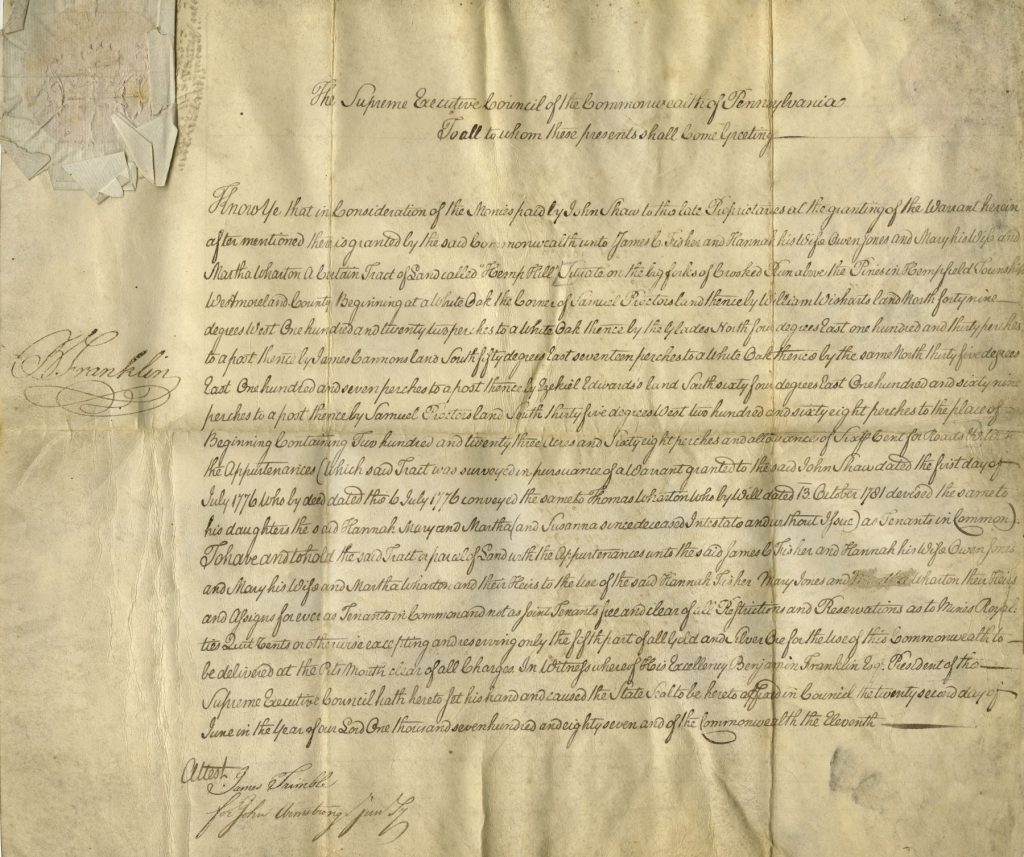Benjamin Franklin, as President of Pennsylvania, Restores Land Confiscated From Loyalist Thomas Wharton During the Revolution to His Heirs


They were members of the prominent Wharton family, one of whom had preceded Franklin in this office.
Franklin signed this document during the Constitutional Convention, which was taking place at that moment in the same building
The Wharton family was one of the most prominent Quaker families in early Pennsylvania, well known both for their political and mercantile influence. When the Revolution broke out, however, allegiances were divided. Thomas...
Franklin signed this document during the Constitutional Convention, which was taking place at that moment in the same building
The Wharton family was one of the most prominent Quaker families in early Pennsylvania, well known both for their political and mercantile influence. When the Revolution broke out, however, allegiances were divided. Thomas Wharton, Jr., was a strong patriot who became President of Pennsylvania (as the Governor was then known). His cousin, also named Thomas Wharton (and referred to as Thomas Sr. to distinguish himself from his cousin), was a well known merchant in Philadelphia, and a partner in establishing the newspaper “The Chronicle”, as well as an acquaintance of Benjamin Franklin. He was also a philanthropist who often helped at the Pennsylvania Hospital, and a shrewd businessman who conducted many successful land ventures in the West. But he took a different path, originally siding with the colonists, but then opposing their action to take up arms against the British. He, as well as other Friends, came under suspicion for refusing to sign an oath of allegiance in 1777 and were sent to Virginia. Thomas was allowed to return to Philadelphia in 1778 but, still considered an enemy to the patriot cause, he lost all of his land under the Confiscation Act of Pennsylvania.
Thomas had three daughters: Hannah who married James C. Fisher (who also played a role in the Wharton family mercantile business); Mary who married Owen Jones, whose family were also prominent merchants; and Martha who never married. In 1781 he made out his will, leaving his property to them. The Revolution by then was drawing to an end, and in 1782, the year the peace treaty was signed, Wharton died. His heirs clearly requested that the state restore Thomas’s confiscated lands to them. This document is proof that the state complied.
Document signed, Philadelphia, June 22, 1787, granting “James C. Fisher and Hannah his wife, Owen Jones and Mary his wife, and Martha Wharton a certain tract of land called Hemp Hill” in Westmoreland County, which is just east of Pittsburgh. The document, which is anything but your typical form document, continues on to give a history of the property and names the heirs. On July 1, 1776, the state of Pennsylvania granted John Shaw ownership of this land and the right to survey it. On July 6, two days after passage of the Declaration of Independence in the same building, Shaw conveyed the land to Thomas Wharton, Sr. In 1781 the land was devised by him to his daughters Hannah, Mary and Martha as tenants in common, and in this document, that provision of Thomas’s will was confirmed by the state. It concludes by saying, “In witness whereof, His Excellency Benjamin Franklin, Esq., President of the Supreme Executive Council, hath hereto set his hand…” The document’s seal is still present. Interestingly, Franklin signed this document during the Constitutional Convention, which was taking place at that moment in the same building.
Although it is well known that the property of many loyalists was confiscated during the Revolution, we do not ever recall seeing any of that property restored. This clearly speaks to the influence of the Whartons and their friends in government circles, and perhaps to lingering gratitude to Thomas Wharton, Jr. for his sacrifices during the war.
This document comes with a manuscript survey of the property dated 1797, and a 19th century document concerning the same property.

Frame, Display, Preserve
Each frame is custom constructed, using only proper museum archival materials. This includes:The finest frames, tailored to match the document you have chosen. These can period style, antiqued, gilded, wood, etc. Fabric mats, including silk and satin, as well as museum mat board with hand painted bevels. Attachment of the document to the matting to ensure its protection. This "hinging" is done according to archival standards. Protective "glass," or Tru Vue Optium Acrylic glazing, which is shatter resistant, 99% UV protective, and anti-reflective. You benefit from our decades of experience in designing and creating beautiful, compelling, and protective framed historical documents.
Learn more about our Framing Services








































































































